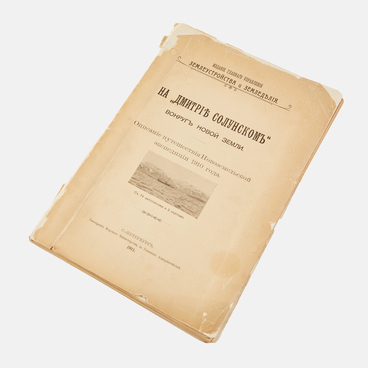The Rusanov Memorial House presents a unique exhibit — a message from a bottle released into the ocean by Vladimir Rusanov’s expedition.
In his article “On the Issue of the Northern Sea Route to Siberia”, Vladimir Rusanov wrote that objects drifting on the surface of water can be used to provide information about surface sea currents in the Arctic. This method was used to study surface currents in many seas around the globe. Metal balls, wooden barrels, and ordinary bottles were used as drifters and contained questions and instructions in several languages. In his research Rusanov used drift bottles.
The method of studying currents by using observations of freely drifting objects was suggested by nature itself. Long before the discovery of America, in the 15th century, fragments of trees, fruits, and sometimes man-made objects were found off the coast of northwestern Europe. On the island of Porto Santo near Madeira, where Columbus lived for some time, he saw a piece of wood with strange carvings. He found it on the shore — apparently the object had been brought by a current. Subsequently, it turned out that those objects were brought by currents from the shores of the Caribbean Sea, the Gulf of Mexico, and the Antilles. However, before the 18th century, it did not occur to people to take advantage of these “instructions” and use drifters to understand naval currents.
The first attempt of this kind was most likely made in 1763 by the Frenchman Laganiere, who lived for a long time on the island of Dominica (the Antilles) and made meteorological observations. On his way back to France, he threw bottles with messages overboard along the way. A total of 14 bottles were thrown, and one of them, thrown at 47° north latitude and 28° west longitude, was found on the coast of Brittany in France. The most large-scale experiment of this kind was carried out in the North Atlantic Ocean by Prince Albert of Monaco in 1885, 1886, 1887 and 1888, when he threw 1,675 drifters into the ocean to study the Gulf Stream and its branches. 226 drifters (that is 13.5%) were found.
To reduce the wind factor, the bottles are
ballasted with sand so that only the neck is visible from the water. Sometimes,
for the same purpose, two bottles are used: they are tied with a short wire,
the lower one is filled with sand so that only the neck of the upper bottle is
visible above the water. The top bottle contains a message with the name of the
ship, the time when the bottle was released into water, as well as the latitude
and longitude where this happened. The note in different languages asks the
finder to send it to the stated address.


